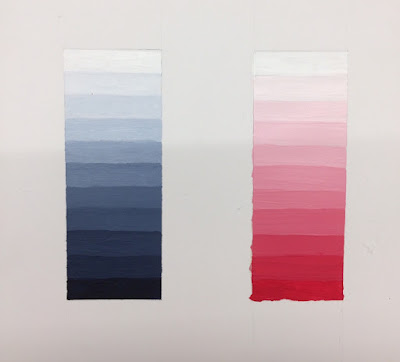Value Scales in 11 steps
Materials: Titanium White and Mars Black, brushes, rulers on Bristol paper
Create a value scale in 11 steps
Overall the scale will be 2" x 11"
Overall the scale will be 2" x 11"
It should look smooth overall - the steps evenly distributed.
The #6 block = your middle grey, therefore, separates half of the value scale towards the TINTS. On the other side of #6 will separate your value scale into TONES.
Simple Color Wheels in six steps
R Y B = Primaries
G V O = Secondaries
Compliment Pairing = 2 colors and ALWAYS is one primary + one secondary. Complimentary colors ALWAYS sit across from each other.
R = G
B = O
V = Y
In the scale below note how each of the scales range in their complementary pairs in seven steps. Each mixing towards the darker color adds overall darkness to the value. Take special note that on the 4th step, the "middle grey" seems to appear equal in saturation and value throughout each of the scales represented in the lower example.
In the scale below note how each of the scales range in their complementary pairs in seven steps. Each mixing towards the darker color adds overall darkness to the value. Take special note that on the 4th step, the "middle grey" seems to appear equal in saturation and value throughout each of the scales represented in the lower example.
Analogous Colors ALWAYS share a border and are three
R O V
V R B
B G V
G Y B
O Y R

